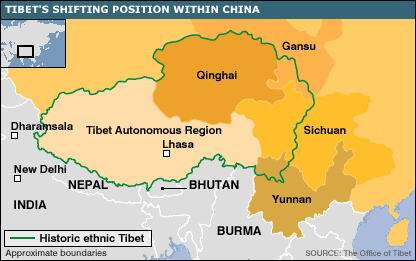The second session of the 11th People’s Congress of Tibet Autonomous Region (TAR), Tibet’s governing body under the Chinese régime, took place in Lhasa, the capital of Tibet, from January 10. At the Congress, the Chinese government reported on Tibet’s GDP figures and tourist inflow in very positive terms— but Tibetan researchers say the data released is likely to be manipulated.
Local legislators delivering their annual reports at the Congress detailed “huge development in social, ecological and religious sectors in Tibet in 2018”, along with a 10% growth in GDP.
“With the launch of more than 700 poverty alleviation projects, training of 36,000 poverty-stricken farmers and herdsmen, and providing of 47,000 new jobs in ecological protection, the government of TAR has lifted 180,000 people out of poverty in 2018,” said Qi Zhala, chairman of the regional government at the Congress, adding that his government would create 50,000 new jobs in 2019.

Performers carrying images of Chinese government leaders to mark the 50th founding anniversary of the Tibet Autonomous Region Photo: Reuters
However, jobs with higher salaries and better working conditions always go to the large population of Chinese immigrants settled in the TAR, whose ranks are growing every day thanks to the systemic sinicisation of Tibet by the authorities in Beijing, report several western news dailies, including the New York Times and Washington post.
According to Tibetan and human rights activists, China’s vision is to depopulate the Tibetan plateau under the guise of “poverty-alleviation” and directed at ending the Tibetan nomads’ way of life by removing them from their lands. According to rukor.org, an extensively researched blog describing itself as a discussion site on Tibetan nomads and their fate, the Chinese government has relocated thousands of herders and nomads from rural Tibet to concrete housing with no facilities to accommodate their herds, classifying the nomads as “poor” and living in “inhospitable terrain” –a claim much disputed as nomads are often wealthy and well capable of making a good living from the land. “The depopulating of Tibetan grasslands is all about guaranteeing water supply from Tibet to lowland northern China and this marks an end to Tibetan land tenure security and collective food security,” says the researcher on rukor.org.
Qi Zhala claimed that 33 million tourists visited the Tibet Autonomous Region in 2018, earning the region 49 billion yuan (over US$7 billion / £5.5 billion).
 However, these numbers have been contested by experts. Dr Rinzin Dorjee, researcher at the Tibet Policy Institute points out that the statistics “just don’t add up”. “In June 2018, Xinhua, the Chinese government-run news agency, reported that TAR received 5.6 million tourists. Statistically, if TAR received 5.6 million tourists in the first five months, from January to May of 2018, it means that, in the remaining seven months it received 28 million tourists, which is an astoundingly high figure and rather unconvincing,” writes Dorjee in his report for the institute. He points out that in the freezing winter months very few people visit Tibet; in addition most of the Chinese migrants return to their native towns. “Projecting high figures of tourists in Tibet benefits the administrative promotion of local officials and enables them to receive higher amount of state grants to develop tourist sites,” Dorjee explains.
However, these numbers have been contested by experts. Dr Rinzin Dorjee, researcher at the Tibet Policy Institute points out that the statistics “just don’t add up”. “In June 2018, Xinhua, the Chinese government-run news agency, reported that TAR received 5.6 million tourists. Statistically, if TAR received 5.6 million tourists in the first five months, from January to May of 2018, it means that, in the remaining seven months it received 28 million tourists, which is an astoundingly high figure and rather unconvincing,” writes Dorjee in his report for the institute. He points out that in the freezing winter months very few people visit Tibet; in addition most of the Chinese migrants return to their native towns. “Projecting high figures of tourists in Tibet benefits the administrative promotion of local officials and enables them to receive higher amount of state grants to develop tourist sites,” Dorjee explains.
Qi Zhala also reported on environmental issues in Tibet saying, “There will be a 20-percent growth of investment in ecological protection in 2019 […] The region will continue making efforts in protecting its forests, grasslands, wetlands and biodiversity, building ecological safety barrier, and curbing desertification and soil erosion.”The Congress report stated “Last year, 10.7 billion yuan (US$1.58 billion) was invested in ecological safety barrier protection and construction. A total of 75,000 hectares of trees were planted, with the forest coverage rate increased to 12.14 percent.” Again, these claims can be contested in the face of global concern about Tibet’s environment and the effect on it of Chinese developments there.
 china.org.cn: “The Tibet Autonomous Regional People’s Congress and its Standing Committee – the local organs of state power in Tibet – fully exercise the power of autonomy bestowed by the Constitution and law, and have actively formulated laws and regulations appropriate to local ethnic and regional characteristics. Both the Chinese Constitution and the Law on Ethnic Regional Autonomy specify that the […] chairman of an autonomous region, the governor of an autonomous prefecture and the head of an autonomous county shall be a citizen of the ethnic group exercising regional autonomy in the area concerned.”
china.org.cn: “The Tibet Autonomous Regional People’s Congress and its Standing Committee – the local organs of state power in Tibet – fully exercise the power of autonomy bestowed by the Constitution and law, and have actively formulated laws and regulations appropriate to local ethnic and regional characteristics. Both the Chinese Constitution and the Law on Ethnic Regional Autonomy specify that the […] chairman of an autonomous region, the governor of an autonomous prefecture and the head of an autonomous county shall be a citizen of the ethnic group exercising regional autonomy in the area concerned.”




 Print
Print Email
Email